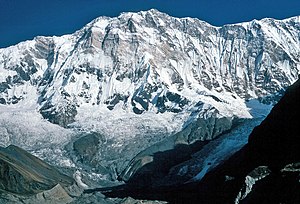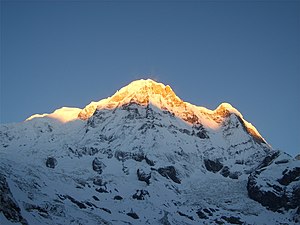Annapurna: Difference between revisions
Added in the first Solo Climb of Annapurna on October 2007, the south face of Annapurna by Tomaz Humar |
|||
| Line 102: | Line 102: | ||
*Koichiro Ohmori, ''Over the Himalaya'', 1998, Cloudcap Press, ISBN 0-938567-37-3 |
*Koichiro Ohmori, ''Over the Himalaya'', 1998, Cloudcap Press, ISBN 0-938567-37-3 |
||
*Jill Neate, ''High Asia: An Illustrated History of the 7000 Metre Peaks'', Mountaineers Books, ISBN 0-89886-238-8 |
*Jill Neate, ''High Asia: An Illustrated History of the 7000 Metre Peaks'', Mountaineers Books, ISBN 0-89886-238-8 |
||
* Reynolds, Kev (2004) Annapurna - A Trekker's Guide. Cicerone, Cumbria ISBN 978 1 85284 397 7 |
|||
==References== |
==References== |
||
Revision as of 11:52, 7 November 2008
| Annapurna | |
|---|---|
 |
Annapurna (Sanskrit, Nepali, Nepal Bhasa: अन्नपूर्णा) is a series of peaks in the Himalaya, a 55 km (34 mi)-long massif of which the highest point, Annapurna I, stands at 8,091 m (26,538 ft), making it the 10th-highest summit in the world and one of the 14 "eight-thousanders". It is located east of a great gorge cut through the Himalaya by the Kali Gandaki River, which separates it from the Dhaulagiri massif. (Dhaulagiri I lies 34 km/21 mi west of Annapurna I.) अन्नपूर्णा Annapūrṇā is a Sanskrit name which literally means "full of food" (feminine form), but is normally translated as Goddess of the Harvests. In Hinduism, Annapurna is a goddess of fertility and agriculture and an avatar of Durga.
The entire massif and surrounding area are protected within the 7,629 sq. km Annapurna Conservation Area Project (ACAP), the first and largest conservation area in Nepal, established in 1986 by the King Mahendra Trust for Nature Conservation. The Annapurna Conservation Area is home to several world-class treks, including the Annapurna Circuit.
The Annapurna peaks are among the world's most dangerous mountains to climb, with a fatality rate of 40%.[1]
Geography
The Annapurna massif contains six major peaks over 7,200 m:
| Annapurna I | 8,091 m | (26,545 ft) Ranked 10th; Prominence=2,894 m | 28°35′42″N 83°49′08″E / 28.595°N 83.819°E |
| Annapurna II | 7,937 m | (26,040 ft) Ranked 16th; Prominence=2,437 m | 28°32′20″N 84°08′13″E / 28.539°N 84.137°E |
| Annapurna III | 7,555 m | (24,786 ft) Ranked 42nd; Prominence=703 m | 28°35′06″N 84°00′00″E / 28.585°N 84.000°E |
| Annapurna IV | 7,525 m | (24,688 ft) | 28°32′20″N 84°05′13″E / 28.539°N 84.087°E |
| Gangapurna | 7,455 m | (24,457 ft) Ranked 59th; Prominence=563 m | 28°36′22″N 83°57′54″E / 28.606°N 83.965°E |
| Annapurna South | 7,219 m | (23,684 ft) Ranked 101st; Prominence=775 m | 28°31′05″N 83°48′22″E / 28.518°N 83.806°E |

Climbing expeditions
Annapurna I

Annapurna I was the first 8,000-metre (26,200 ft) peak to be climbed. Maurice Herzog and Louis Lachenal, of a French expedition (including Lionel Terray, Gaston Rébuffat, Marcel Ichac, Jean Couzy, Marcel Schatz, Jacques Oudot, Francis de Noyelle), reached the summit on 3 June 1950. (See the documentary of the expedition "Victoire sur l'Annapurna" by Marcel Ichac). Its summit was the highest summit attained on Earth for three years, until the first successful ascent of Mount Everest. (However higher non-summit points—at least 8,500 metres (27,900 ft)—had already been attained on Everest in the 1920s.)
The south face of Annapurna was first climbed in 1970 by Don Whillans and Dougal Haston, members of a British expedition led by Chris Bonington which included the alpinist Ian Clough, who was killed by a falling ice-pillar during the descent. They were, however, beaten to the second ascent of Annapurna by a matter of days by a British Army expedition led by Henry Day.
In 1978, The American Women's Annapurna Expedition, a team led by Arlene Blum, became the first American team to climb Annapurna I. The expedition was also remarkable for being composed entirely of women. Alison Chadwick-Onyszkiewicz and Vera Watson died during this climb. (Vera Watson was the wife of computer scientist John McCarthy.)
On 3 February 1987, Polish climbers Jerzy Kukuczka and Artur Hajzer made the first winter ascent of Annapurna I.
With a fatality rate of 40%, and as of 2005, only 103 successful summits have been made, for the loss of 56 lives, many to the avalanches for which the mountain is known. Climbers killed on the peak include famed Russian climber Anatoli Boukreev in 1997, Christian Kuntner in 2005 and Iñaki Ochoa in 2008 [2]
First Solo climb was October 2007 on the South Face by Slovenian climber Tomaz Humar.
The other peaks

Annapurna II, the eastern anchor of the range, was first climbed in 1960 by a British/Indian/Nepalese team led by Jimmy Roberts, via the West Ridge, approached from the north. The summit party comprised Richard Grant, Chris Bonington, and Sherpa Ang Nyima. In terms of elevation, isolation (distance to a higher summit, namely Annapurna I, 30.5 km (19.0 mi)*) and prominence (2,437 m (7,995 ft)*), Annapurna II does not rank far behind Annapurna I. It is a fully independent peak, despite the close association with Annapurna I which its name seems to imply.
Annapurna III was first climbed in 1961 by an Indian expedition led by Mohan Kohli, via the Northeast Face. The summit party comprised Mohan Kohli, Sonam Gyatso, and Sonam Girmi.
Annapurna IV, near Annapurna II, was first climbed in 1955 by a German expedition led by Heinz Steinmetz, via the North Face and Northwest Ridge. The summit party comprised Steinmetz, Harald Biller, and Jürgen Wellenkamp.
Gangapurna was first climbed in 1965 by a German expedition led by Günther Hauser, via the East Ridge. The summit party comprised 11 members of the expedition.
Annapurna South (also known as Annapurna Dakshin, or Moditse) was first climbed in 1964 by a Japanese expedition, via the North Ridge. The summit party comprised S. Uyeo and Mingma Tsering.
Hiunchuli (6,441 m/21,126 ft) is a satellite peak extending east from Annapurna South, Hiunchuli was first climbed in 1971 by an expedition led by U.S. Peace Corps Volunteer Craig Anderson.
Machapuchare (6,993 m (22,943 ft)*) is another important peak of the Annapurna Himal, though it just misses the 7,000 metre mark. Machapuchare and Hiunchuli are prominently visible from the valley of Pokhara. These peaks are the "gates" to the Annapurna Sanctuary leading to the immense south face of Annapurna I.
Trekking

The Annapurna Conservation Area is a well known trekking region.
There are three major trekking routes in the Annapurna region: the Jomson Trek to Jomsom and Muktinath (increasingly disturbed by a road-building project); the Annapurna Sanctuary route to Annapurna base camp; and the Annapurna Circuit, which circles the Annapurna Himal itself and includes the Jomson route. The town of Pokhara usually serves as a starting point for these treks, and is also a good starting place for other short treks of one to four days, such as routes to Ghorepani or Ghandruk.
The Mustang district, a former kingdom bordering Tibet, is also geographically a part of the Annapurna region, but treks to Mustang are subject to special restrictions.
About two-thirds of all trekkers in Nepal visit the Annapurna region. The area is easily accessible, guesthouses in the hills are plentiful, and treks here offer incredibly diverse scenery, with both high mountains and lowland villages. Also, because the entire area is inhabited, trekking in the region offers unique cultural exposure and experience.
See also
Other articles
- Tilicho lake
- Annapurna also refers to some breath-oriented techniques of meditation.
Sources
- Koichiro Ohmori, Over the Himalaya, 1998, Cloudcap Press, ISBN 0-938567-37-3
- Jill Neate, High Asia: An Illustrated History of the 7000 Metre Peaks, Mountaineers Books, ISBN 0-89886-238-8
- Reynolds, Kev (2004) Annapurna - A Trekker's Guide. Cicerone, Cumbria ISBN 978 1 85284 397 7
References
External links
- Map of Annapurna Range
- Annapurna on Peakware
- Annapurna I on summitpost.org
- The Annapurna Conservation Area Project (ACAP)
- An Online Trekking Guidebook for the Annapurna Circuit
- The Annapurna Circuit : Photo Essay from 20 days Trekking round the Annapurna Massif
- Trying to conquer the peak : The death story of Inaki Ochoa attempting to reach the peak of Annapurna May 2008
- Trekking to Annapurna Base Camp by Rangan Datta
- Ueli Steck scales new heights : The story of Ueli Steck's rescue attempt of Inaki Ochoa Annapurna May 2008
- Ascent and fatality statistics

